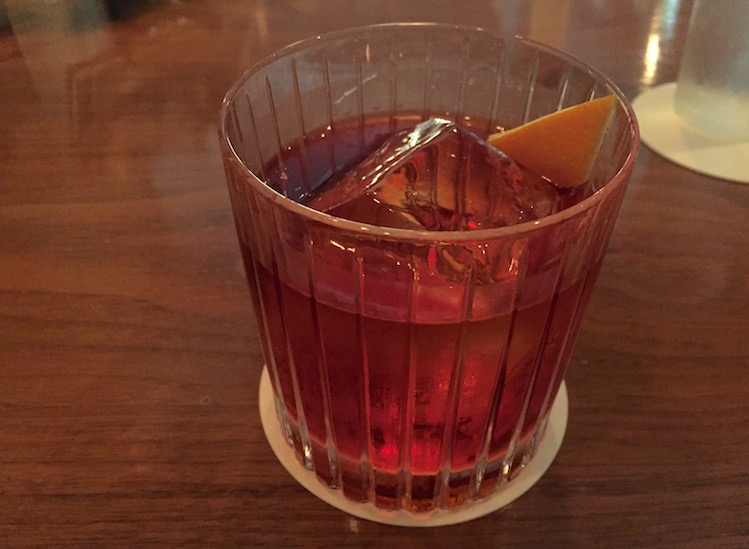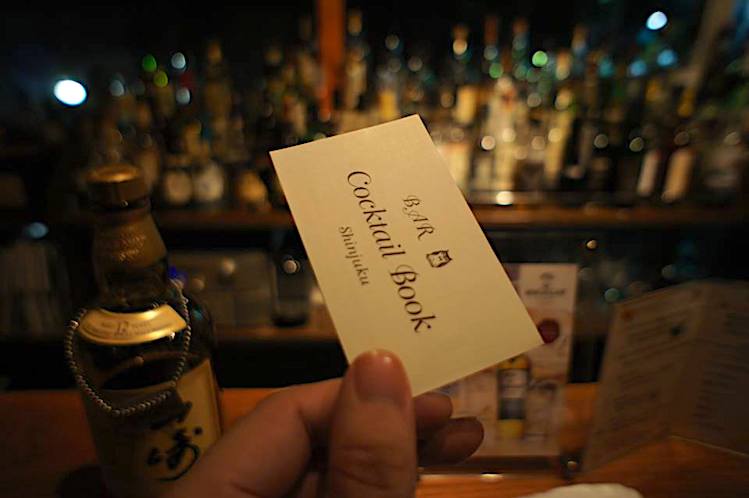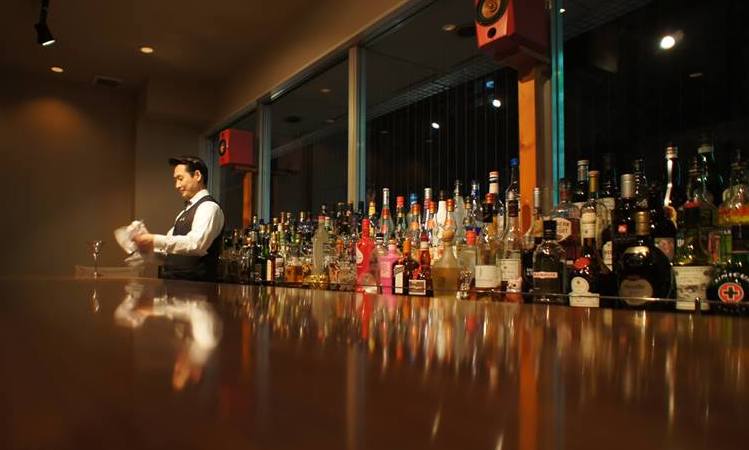When I set out for Tokyo, I had my bars picked out. No matter that it was the largest city in the world: I’d made up my mind to spend my nights at must-visit spots like Bar High Five and Zoetrope. But as my two brothers and I walked back to our Airbnb in the lively Shinjuku neighborhood one night, I noticed a sign for “Bar Cocktail Book.”
Tokyo hides bars in buildings the way teenagers hide contraband in sock drawers: nothing is visible at first, but start looking a little closer and they’ll practically fall out around you. The first floor of the building was an Italian restaurant specializing in pasta, with Bar Cocktail Book located on its upper floor. Aside from the name, the only thing the sign revealed was the bar’s mascot: a sketched owl wearing a bowtie. That was enough to get me upstairs.
We walked into a long, narrow room with the dimensions of a train car. It was dominated by a meticulously polished wooden bar with less than a dozen seats. The immense back bar was stocked with an enviable assortment of Japanese and Western whiskeys.
The rest of this beautiful, meticulously organized bar appeared to be unadorned—until I noticed the owls. The small figurines stood sentinel over certain bottles, and a colored sketch of an owl was stuck to one of the wooden beams that held up the bar’s speakers.
There was another, larger figure behind the bar that also appeared ornamental at first sight. He was a man wearing a white shirt with french cuffs, a black vest and a black bowtie. His dark hair was cropped short on the sides, but swept high up top à la Tin Tin. He looked the way you’d expect a bartender to appear in a Savoy Cocktail Book illustration—with the exception that this was real life.

Negroni at Bar Cocktail Book.
There was one other occupant at the bar, a man seated at the chair furthest from us. We watched the bartender make his drink. Each of his movements was precise, from the way he neatly laid each bottle out on the bar before mixing, to the metronomic flick of his wrist as he stirred. He was mechanical in his deliberateness, poetic in his perfection. I was tempted to compare him to a cocktail-making android, but his technique revealed a devotion to the craft that no programming could imitate. We had entered the bar wanting a drink, but imbibery itself had become a secondary goal: now we just wanted to order drinks to watch them be made.
The bartender greeted us in customarily polite fashion, but added that his English was not very good. Other than a specials card promoting three drinks made with Royal Lochnagar whisky, there was no menu. I was at a loss until I recalled a single word of Japanese, known to anyone who’s ever visited a suburban sushi restaurant: “Omakase.”
The bartender acknowledged it, and began arranging bottles on the bar counter, taking special care to place them exactly in line with one another. I recognized Averna and a brand of club soda I’d seen in other Japanese bars—the rest were unknown to me. Using the same beautiful precision I had witnessed from the other side of the bar, he measured out and poured the spirits into a highball glass with two substantial, hand-carved ice cubes. He finished it with club soda and passed me the drink.
This amaro highball was tart, acidic, funky, and bitter. It was unlike any highball, or cocktail, I’d had before. I asked for his permission to study the bottles, and learned that one was a Japanese plum cordial. My brother ordered a Martini—a word recognizable in any language—which was made with the same loving dedication.
The bartender’s service did not end with the completion of the drinks. After we had taken our first few sips, he placed a white plate before each of us. He took something out of a microwave behind the bar, removed it with tweezers, and set it before us. It was a warm, moist hand towel: the kind you might receive on a first-class flight.
After we had washed and rejuvenated our hands, he removed the plates and served us each a long, narrow dish. A trio of small snacks was on each dish, arranged in perfect distance from one another. On my plate was a handful of corn nuts, raisins with a piece of dried ginger, and a tiny piece of cured ham skewered by a toothpick.

As I finished this unexpected snack, I noticed that a CD case was propped up by a plastic dock on the counter. When the music that had been playing from the bar’s speakers stopped, the bartender placed a new CD into the stereo. The moment this new jazz album began playing, he removed the previous CD case and displayed the one belonging to the newest album. This act, done with just a few patrons at his bar in the waning hours of a weeknight, provoked two thoughts: 1) that this was the most OCD bar I had ever been to, and 2) that it was possibly the best.
More drinks followed. Despite his earlier proclamation, the bartender knew enough English to sustain some short conversation. We learned that his name was Akira Okamura. He was the owner, and sole employee of the bar. He told us that an enormous trophy displayed in the bar was for coming in first place at a cocktail competition (later Googling suggests that he won 1st place at the 2016 Hotel Barman’s Association Cocktail Competition). He told us about how rare certain Japanese whiskies were getting even in their home country, and gave us incredibly detailed directions to a nearby liquor store where he claimed some could still be found.
After a round of Negronis served over perfectly symmetrical ice octagons—and a Boulevardier made with Hibiki Harmony—Akira placed a bottle of Nikka 12 on the counter, though none of us had ordered any. He poured a generous amount of the discontinued whisky into four rocks glasses, passing one to me, my two brothers—and himself. As we raised our glasses and said “Kampai,” I added an additional toast in my head to the international language of hospitality—something on full display at Bar Cocktail Book.



